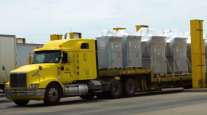Senior Reporter
Class 8 Orders Surge 22%

This story appears in the Feb. 13 print edition of Transport Topics.
North American Class 8 orders in January surged 22% year-over-year, besting analysts’ expectations to post the highest total in 13 months.
Orders reached 22,200, up from 18,197 a year earlier, according to ACT Research Co., citing data that would be revised before the end of February.
The January gain marks only the second positive year-over-year comparison in 23 months, ACT said. The other month was November with 19,440 orders, up from 16,770 in November 2015.
The one prior to that was February 2015, with 31,158 orders, compared with 29,225 in February 2014, according to ACT.
“They were definitely above our expectations and what we had baked into our forecast,” ACT Vice President Steve Tam told Transport Topics about the January orders.
The January gains led to a slight uptick in ACT’s forecast.
“Nothing significant; almost a symbolic recognition of, ‘Yes, that was a good month,’?” he said.
Tam attributed the January increase to a shift in the timing of some of the orders that typically would have occurred in December.
“That’s part of the reason we are not jumping up and down ecstatic,” he said.
ACT’s forecast now calls for North American Class 8 production to reach 205,000 units this year, up from 203,000, he said.
Research company FTR pegged January orders at 21,600, also calling it a preliminary figure.
“My forecast was 19,000, so [January orders] exceeded that by 14%. It’s above expectations but not greatly surprising,” said Don Ake, vice president of commercial vehicles at FTR.
From October to January, orders have been almost the same, Ake pointed out. “You don’t see stability like that very often. It looks like you have some momentum here in the market that people did not expect.”
FTR increased its North American Class 8 production forecast this month to 213,000 from 211,000.
Stifel, Nicolaus & Co. analyst Michael Baudendistel wrote in an investor note that while orders are not surging, they continue to look incrementally better.
“Recent commentary from [truck makers] around their conversations with customers, and from the carriers directly, have indicated more willingness from fleets to commit capital to equipment following a pullback in orders in 2016,” he explained.
Another analyst pointed to a likely improvement in rates.
Preliminary expectations for 2017 based on public truckload carriers’ fourth-quarter earnings reports “call for low single-digit [pricing] growth year-over-year,” Benjamin Hartford, an analyst with Robert W. Baird & Co., wrote Feb. 6 in a note to investors.
That would be consistent with Baird’s 2017 forecast of up to 2% growth year-over-year and also would be above Baird’s estimate of a decline in core pricing of 2-3% in the fourth quarter of 2016, year-over-year, according to the note.
But the stronger pricing probably still is a few months out. “Pricing growth is broadly expected to be back-half-weighted [in 2017] following a still-pressured bid season but improve throughout the year,” Hartford wrote.
Ake added that if the January Class 8 production number is higher than expected, FTR’s forecast will increase again.
“I get the impression [operational] costs are stabilizing, and once costs stabilize, fleets can manage them better, and that gives [fleets] more certainty [about placing equipment orders],” he said, adding that the general economic forecasts probably are too low.
“But with so many political variables, who knows? Eventually, this will settle down and there will be whatever reality is,” he said.
One potential variable is on the mind of trade group American Truck Dealers, which said it remains concerned that expected federal efforts to fund infrastructure improvements might lead to an increase in the truck federal excise tax.
“FET is the highest excise tax on a percentage basis that Congress levies,” ATD said in an online post describing its legislative priorities. The tax typically increases the cost of a new Class 8 truck between $12,000 and $22,000, according to the group.
“This burdensome tax is in addition to the more than $30,000 in new federal emissions and fuel-economy mandates that, when fully implemented, will make it harder for small businesses to afford a new heavy- duty truck,” ATD said.
The tax, which began in 1917, was intended to help defray the expense of World War I, the group said.
“This tax on most new heavy- duty trucks, tractors and trailers has grown from 3% when it was incorporated into the Highway Trust Fund in 1955 to 12% today,” ATD said.




